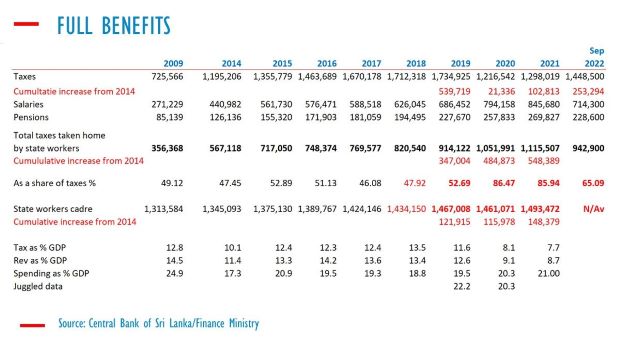COLOMBO – Sri Lanka’s taxes taken home by state workers and pensioners fell to 65 cents of every rupee collected up to September 2022 from 86 cents with more revenues being extracted from the public through high inflation and hikes in rates, official data show.
Sri Lanka’s salary and pension bill as share of taxes was 942 billion rupees up to September 2022 and pensions were 228.6 billion rupees, totalling 942.9 billion rupees.
Revenues up to September 2022 rose to 1,448 billion rupees, up from 1,298 billion rupees for the full year 2021.
As a share of taxes, the wage and pension bill fell to 65.09% of the tax revenues up to September from 85.94% in 2022.
Sri Lanka’s wage bill and the public sector expanded under so-called ‘revenue-based fiscal consolidation’ an unusual state expansion strategy peddled to Sri Lanka in line with Western anti-austerity ideology where ‘spending-based consolidation’ (cost cutting) was rejected.
Under revenue-based consolidation more and more taxes were collected from the people and state spending was allowed to expand, putting the entire burden of fiscal correction on the general public.
Taxes as a share of GDP went up from 10.1% of GDP in 2014 to 11.6 % in 2019.
But overall spending to GDP expanded from 17% of GDP in 2014 to 19.5% under revenue based fiscal consolidation.
The wage bill which was 47 cents of every tax rupee in 2014 rose to 52 cents by 2019. The public service was also expanded from 1.345 million persons to 1.467 million persons in line with the revenue based fiscal consolidation anti-state austerity ideology.
Under revenues based fiscal consolidation sans spending based consolidation an extra 539.7 billion rupees were collected from the people by 2019 compared to 2014. Of the total 347 billion was given to state workers as salaries and pensions.
Meanwhile, the central bank printed money to suppress rates under ‘flexible inflation targeting’ triggering currency crises even as deficits were brought down, leading to growth shocks as corrective policies were applied and currency depreciation sapped purchasing power.
The rupee fell from 131 to 182 under flexible inflation targeting.
In 2019 economic bureaucrats in addition to printing money for ‘stimulus’ also cut taxes saying there was a ‘persistent output gap’, triggering a fiscal crisis.
The International Monetary Fund (IMF) gave technical assistance to Sri Lanka to calculate an output gap, encouraging monetary stimulus.
Wages as a share of taxes shot up to 86% in 2020.
In 2021 the retirement age of state workers were increased by then Finance Minister Basil Rajapaksa.
A collapse of the currency from 200 to 360 to the US dollar has fired inflation and is boosting revenues, while taxes rates have been raised.
Up to September rupee tax revenues surged 38%.
Income tax rates have been raised amid repeated calls by politicians and urban intelligentsia to increase ‘direct taxes’. But now there is a backlash from professional grade workers as marginal tax rates were pushed to 34%.
This year wages have been frozen.
President Ranil Wickremesinghe however is trying to bring spending-based consolidation back, reducing the retirement age.
-economynext.com



Comments are closed, but trackbacks and pingbacks are open.